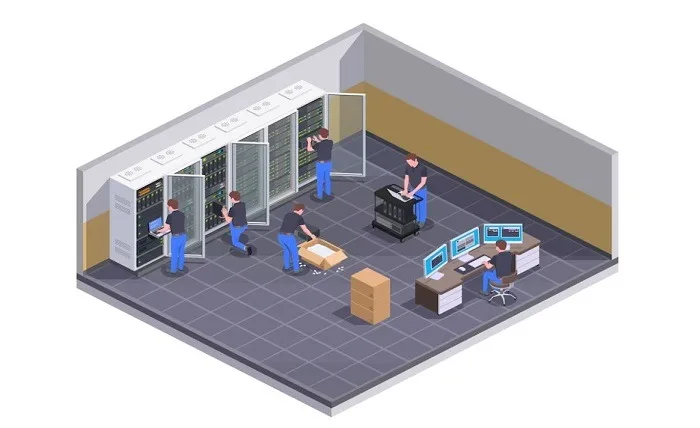When being in operation, IT equipment tends to heat well. Components emit much heat when performing computing tasks, processing datum, etc. Thus, the issue of cooling is vital for every network system. A properly developed chilling strategy will secure hardware from malfunction, premature deterioration, and downtime, while a poorly designed system will lead to overheating and equipment breaking.
The modern industry offers several solutions for enabling effective cooling. In the article, we’re going to consider the most popular types of cooling system in data center, outline the benefits and shortcomings of each technology, and clarify other related questions.
Types of Cooling Strategies for DCs
There is a variety of data center cooling system types. For instance, the use of raised floors, immersion chilling, Calibrated Vector Unit, Close Coupled DC Units, etc. Thus, it is possible to pick a suitable solution for any facility, business, and budget. An assortment of server rack cooling devices is provided by Sysracks.
Below, you’ll find out accurate information about the most advanced and common types of data center cooling systems in the industry.
Free cooling
This technique comes as a cost-effective solution to use the exterior atmosphere in favor of hardware chilling. According to this method, cooler air from the atmosphere is used to reduce the temperature of operating devices. System chilling is applied by means of natural air or water.
It is an effective server rack cooling, but it is not used for enclosed cabinets. Open-frame racks let the airflow freely pass through devices, which makes this system highly effective. Walls and doors of solid enclosures impede air penetration, making the strategy ineffective.
Indispensable benefits of this solution include low expenses on ventilation devices and cost-effectiveness due to the use of natural resources. Yet, the drawback is that pollutants, debris, and other waste can penetrate server racks and hardware with the air.
CRAC (Computer Room Air Conditioner)
Big industrial-scale conditioners are widely mounted in data centers to force the airflow to go in the right direction and cool down hardware. A compressor is installed in a conditioner to reduce the temperature and humidity in a room. This solution is affordable but inefficient in terms of power use. It consumes too much energy during functioning.
CRAH (Computer Room Air Handler)
These systems work using liquid cooling, i.e. a water plant is an obligatory part of the system. A chilling coil is placed in the unit, and cold water travels through it. When passing through devices, cold water takes heat and removes it from the facility. Modulating fans are also applied to extract the airflow from the environment. This solution reaches maximum efficiency in areas with colder environments since no forced cooling is needed, and water does not lose cold when passing through the atmosphere.
Evaporative Chilling
According to this technique, warm air is exposed to water, which causes evaporation. As a result, the air is cooled down. It is one of the most popular server rack cooling best practices, which is based on liquid chilling. If compared to CRAH and CRAC units, this solution is more energy-efficient since it requires less feeding. Yet, it consumes a lot of water; thus, water towers are usually placed next to DCs with this type of cooling.
Direct-To-Chip Cooling
In this case, liquid participation is also required. The scheme is the following: a cold plate is incorporated into motherboard processors to disperse heat. A cooling mixture travels to a cold plate through pipes. Coolant takes heat and directs it into a chilled water loop. This method is highly targeted as it cools down particular parts of the network system, which makes it very effective. This strategy comes as one of the most innovative data center cooling techniques.
Chilled Liquid Technology
Here’s another liquid technology. In this case, a chiller is applied for reducing the liquid temperature. Chilled water travels through coils and pipes to targeted hardware. It absorbs heat, exchanges it for cold, and brings hot water into the chiller, where the liquid is chilled again in a cooling tower. This circulation repeats again and again. Liquid cooling is considered to be more effective since it is more precise. Water routes are targets for certain units.
Cold Aisle/Hot Aisle Containment
This technology is based on the concept of air aisles’ allocation in rooms. When arranging and setting data centers, system administrators use air maps to design cooling more effectively. According to this concept, cold aisles bring chilled air, so the front side of the rack should be placed so that to let the air enter the body. Ventilation systems (fans and HVAC) are usually placed nearby hot aisles to absorb excess heat and chill the air. After chilling, it is redirected to the cold aisle to circulate the scheme once again. Using hot/cold aisle maps when arranging cabinets and racks helps reduce the need for alternative cooling methods and achieve more effective air chilling.
Note that both rooms and cabinets/racks themselves require cooling. Thus, system administrators frequently mix several cooling techniques. For instance, they place cabinets in accordance with aisle maps, install HVAC systems on premises, and add liquid cooling directly into cabinets.
Finally, remember that the stable and durable performance of network equipment depends on the density of hardware accommodation. Technicians always place devices loosely to guarantee free airflow between them. Otherwise, devices will exchange heat, which results in quick overheating and downtime.



